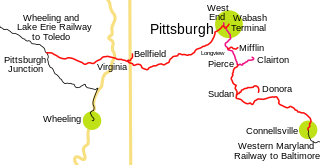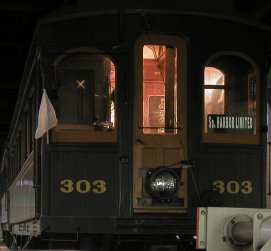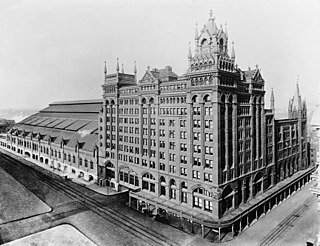Related Research Articles

The Baltimore and Ohio Railroad was the first common carrier railroad and the oldest railroad in the United States. It operated as B&O from 1830 until 1987, when it was merged into the Chessie System; its lines are today controlled by CSX Transportation.
The Pennsylvania Railroad, legal name The Pennsylvania Railroad Company, also known as the "Pennsy", was an American Class I railroad that was established in 1846 and headquartered in Philadelphia, Pennsylvania. At its peak in 1882, the Pennsylvania Railroad was the largest railroad, the largest transportation enterprise, and the largest corporation in the world, on par with the London & North Western Railway.

The New York Central Railroad was a railroad primarily operating in the Great Lakes and Mid-Atlantic regions of the United States. The railroad primarily connected greater New York and Boston in the east with Chicago and St. Louis in the Midwest, along with the intermediate cities of Albany, Buffalo, Cleveland, Cincinnati, Detroit, Rochester and Syracuse. The New York Central was headquartered in the New York Central Building, adjacent to its largest station, Grand Central Terminal.

John Edgar Thomson was an American civil engineer and industrialist. An entrepreneur best known for his leadership of the Pennsylvania Railroad (PRR) from 1852 until his death in 1874, Thomson made it the largest business enterprise in the world and a world-class model for technological and managerial innovation. Previously the railroad's first chief engineer, he became its third president.

The Western Maryland Railway was an American Class I railroad (1852–1983) that operated in Maryland, West Virginia, and Pennsylvania. It was primarily a coal hauling and freight railroad, with a small passenger train operation.
The National Railway or National Air Line Railroad was a planned air-line railroad between New York City and Washington, D.C. in the United States around 1870. Part of it was eventually built from New York City to Philadelphia by the Delaware and Bound Brook Railroad and the Delaware River Branch of the North Pennsylvania Railroad, leased by the Philadelphia and Reading Railway, in 1879, and becoming its New York Branch. The line was intended to provide an alternate to the various monopolies that existed along the route, specifically the United New Jersey Railroad and Canal Companies and their Camden and Amboy Railroad, and as such had a long struggle to be built.
The Genesee Valley Canal Railroad was a part of the Pennsylvania Railroad system in western New York. It was built on the former Genesee Valley Canal alignment.
The Pittsburgh, Fort Wayne and Chicago Railway was a major part of the Pennsylvania Railroad system, extending the PRR west from Pittsburgh, Pennsylvania, via Fort Wayne, Indiana, to Chicago, Illinois. It included the current Norfolk Southern-owned Fort Wayne Line east of Crestline, Ohio, to Pittsburgh, and the Fort Wayne Secondary, owned by CSX, from Crestline west to Tolleston in Gary, Indiana. CSX leased its entire portion in 2004 to the Chicago, Fort Wayne and Eastern Railroad (CFE). The remaining portion of the line from Tolleston into Chicago is now part of the Norfolk Southern's Chicago District, with a small portion of the original PFW&C trackage abandoned in favor of the parallel lines of former competitors which are now part of the modern NS system.

The Pittsburgh, Cincinnati, Chicago and St. Louis Railroad, commonly called the Pan Handle Route, was a railroad that was part of the Pennsylvania Railroad system. Its common name came from its main line, which began at Pittsburgh, Pennsylvania, crossed the Northern Panhandle of West Virginia, and continued west to Bradford, Ohio, where it split into a northern line to Chicago and a southern one through Indianapolis, Indiana, to East St. Louis, Illinois.

The Pennsylvania Company was a major holding company. It included the Pittsburgh, Fort Wayne and Chicago Railway, the PRR's main route to Chicago. Together with the Pittsburgh, Cincinnati, Chicago and St. Louis Railroad and Vandalia Railroad, the three railroads were branded by the PRR as Pennsylvania Lines West of Pittsburgh. All lines west merged into the Pennsylvania Railroad in 1921.

The Pittsburgh and West Virginia Railway was a railroad in the Pittsburgh, Pennsylvania, and Wheeling, West Virginia, areas. Originally built as the Wabash Pittsburgh Terminal Railway, a Pittsburgh extension of George J. Gould's Wabash Railroad, the venture entered receivership in 1908, and the line was cut loose. An extension completed in 1931 connected it to the Western Maryland Railway at Connellsville, Pennsylvania, forming part of the Alphabet Route, a coalition of independent lines between the Northeastern United States and the Midwest. It was leased by the Norfolk and Western Railway in 1964 in conjunction with the N&W acquiring several other sections of the former Alphabet Route but was leased to the new spinoff Wheeling and Lake Erie Railway in 1990, just months before the N&W was merged into the Norfolk Southern Railway.
The Northeast and the Great Lakes states are connected by an east-west railroad corridor. The endpoints of this corridor are New York City and Chicago. Along the way, the corridor passed through cities such as Philadelphia, Baltimore, Washington, D.C., Pittsburgh, Buffalo and Cleveland. There were branches off the corridor to cities such as Cincinnati, Detroit, Indianapolis, and St. Louis. For over a century, this corridor was dominated by four major railroads, and an aggregate of other railroads that served as a fifth option.
In addition to streetcar lines, the Van Sweringen Brothers of Cleveland, Ohio owned a vast network of steam railroads.

Cleveland has been and continues to be deeply rooted in railroad history.
The following is a brief history of the North American rail system, mainly through major changes to Class I railroads, the largest class by operating revenue.
The following is a brief history of the North American rail system, mainly through major changes to Class I railroads, the largest class by operating revenue.

The Philadelphia, Baltimore and Washington Railroad (PB&W) was a railroad that operated in Pennsylvania, Delaware, Maryland, and the District of Columbia in the 20th century, and was a key component of the Pennsylvania Railroad (PRR) system. Its 131-mile (211 km) main line ran between Philadelphia and Washington. The PB&W main line is now part of the Northeast Corridor, owned by Amtrak.

Akron Union Station was a series of three union stations serving several passenger railroads in Akron, Ohio from 1852 to 1971. The station's tenants included the Baltimore & Ohio Railroad, Pennsylvania Railroad and Erie Railroad. It was a hub, serving train companies serving destinations in different directions, west, north, south and east.
References
- PRR Chronology Archived 2013-12-22 at the Wayback Machine
- PRR Corporate History
- Roberts, C. and Messer, D. (2003). Triumph VI, Baltimore: Barnard, Roberts. ISBN 0-934118-28-0